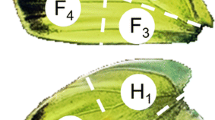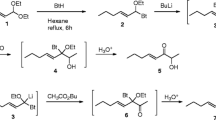Abstract
Male wing compounds involved in maintaining reproductive isolation between the sulfur butterfliesColias eurytheme andC. philodice have been identified. MaleC. philodice produce threen-hexyl esters; myristate, palmitate, and stearate, which are absent inC. eurytheme. A branched hydrocarbon, 13-methylheptacosane, is found on the wings of maleC. eurytheme, but notC. philodice. Several straight-chain hydrocarbons are on the wings of both species. The esters and 13-methylheptacosane have significant electrophysiological activity. Preliminary behavioral experiments indicate that the esters (especiallyn-hexyl myristate) function as species-recognition signals. The esters and 13-methylheptacosane also have low-to-moderate aphrodisiac activity.
Similar content being viewed by others
References
Birch, M.C. 1971. Intrinsic limitations in the use of electroantennograms to bioassay male pheromones in Lepidoptera.Nature (London) 233:57–58.
Birch, M.C. 1974. Aphrodisiac pheromones in insects, pp. 115–134,in M.C. Birch (ed.). Pheromones. North Holland, Amsterdam.
Grant, G.G., Brady, U.E., andBrand, J.M. 1972. Male armyworm scent brush secretion: Identification and electroantennogram study of major components.Ann. Entomol. Soc. Am. 65:1224–1227.
Hovanitz, W. 1944. Genetic data on the two races ofColias chrysotheme in North America and on a white form occurring in each.Genetics 29:1–29.
Hovanitz, W. 1950. The biology ofColias butterflies. I. The distribution of the North American species.Wasman J. Biol. 8:49–75.
Jewett, P.M., Matsumura, F., andCoppel, H.C. 1976. A simple system for recording electro-antennograms from male pine sawflies.J. Electrophysiol. Tech. 5:23–28.
Kaae, R.S., Shorey, H.H., andGaston, L.K. 1973. Pheromone concentration as a mechanism for reproductive isolation between two Lepidopterous species.Science 179:487–488.
Leonard, J.E., andEhrman, L. 1974. Pheromones as a means of genetic control of behavior.Annu. Rev. Genet. 8:179–193.
Miller, J.R., Mori, K., andRoelofs, W.L. 1977. Gypsy moth field trapping and electroantennogram studies with pheromone enantiomers.J. Insect Physiol. 23:1447–1453.
Obara, Y. 1964. Mating behavior of the cabbage white,Pieris rapae crucivora. II. The “materefusal posture” of the female.Zool. Mag. 73:175–178.
Roelofs, W.L., andComeau, A. 1971. Sex pheromone perception: Electroantennogram responses of the red-banded leaf roller moth.J. Insect Physiol 17:1969–1982.
Roelofs, W.L., andCardé, R.T. 1974. Sex pheromones in the reproductive isolation of lepidopterous species, pp. 96–114, M.C. Birch (ed.).in Pheromones. North-Holland, Amsterdam.
Rutowski, R.L. 1977. Chemical communication in the courtship of the small sulfur butterflyEurema lisa (Lepidoptera, Pieridae).J. Comp. Physiol. 115:75–85.
Schneider, D., andSeibt, U. 1969. Sex pheromone of the queen butterfly: Electroantennogram responses.Science 164:1173–1174.
Silberglied, R.E. 1973. Ultraviolet reflection of butterflies. PhD dissertation, Harvard University.
Silberglied, R.E., andTaylor, O.R. 1978. Ultraviolet reflection and its behavioral role in the courtship of the sulfur butterflies,Colias eurytheme andC. philodice (Lepidoptera, Pieridae).Behav. Ecol. Sociobiol. 3:203–243.
Stenhagen, E., Abrahamsson, S., andMcLafferty, F.W. (eds.). 1974. Registry of Mass Spectral Data. John Wiley & Sons, New York.
Tamaki, Y. 1977. Complexity, diversity and specificity of behavior-modifying chemicals in Lepidoptera and Diptera, pp. 253–285,in H.H. Shorey and J.J. McKelvey (eds.). Chemical Control of Insect Behavior. John Wiley & Sons, New York.
Taylor, O.R. 1972. Random vs. non-random mating in the sulfur butterfliesColias eurytheme andC. philodice (Lepidoptera, Pieridae).Evolution 26:344–356.
Wood, D.L., Browne, L.E., Ewing, B., Lindahl, K., Bedard, W.D., Tilden, P.E., Mori, K., Pitman, G.B., andHughes, P.R. 1976. Western pine beetle: Specificity among enantiomers of male and female components of an attractant pheromone.Science 192:896–898.
Author information
Authors and Affiliations
Rights and permissions
About this article
Cite this article
Grula, J.W., McChesney, J.D. & Taylor, O.R. Aphrodisiac pheromones of the sulfur butterfliesColias eurytheme andC. Philodice (Lepidoptera, Pieridae). J Chem Ecol 6, 241–256 (1980). https://doi.org/10.1007/BF00987543
Received:
Revised:
Issue Date:
DOI: https://doi.org/10.1007/BF00987543




